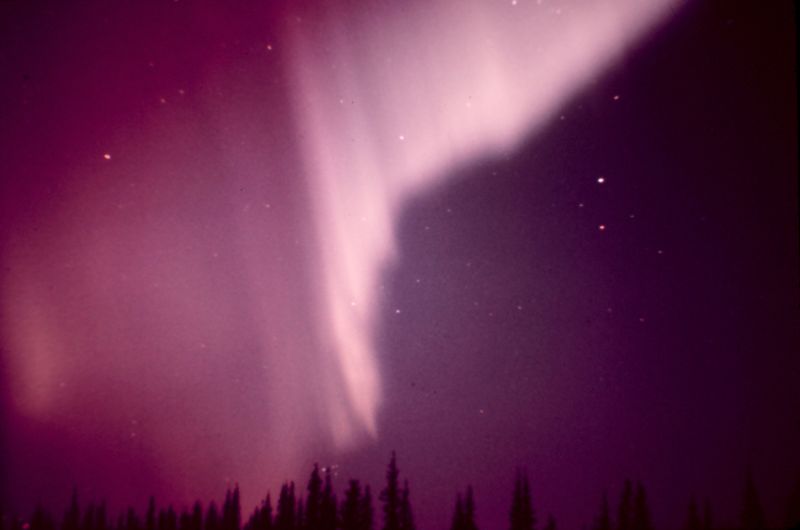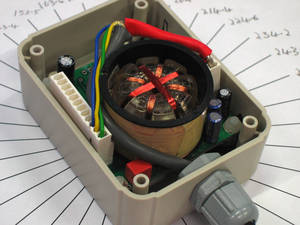Planet Earth - Measuring Earth's Magnetic Field
Interview with
Kat - The Earth is under constant bombardment by a 1 million mile per hour maelstrom of charged particles that continuously stream out of the Sun. We're protected from this solar wind by the Earth's magnetic field luckily, but a sudden surge in solar activity can nonetheless overcome this protective shield, leading to damage the satellites and power lines. A dramatic example of this occurred in the mid-1800s and Planet Earth podcast presenter Richard Hollingham went to meet Geomagnetist Alan Thompson in the archives of the British Geological Survey in Edinburgh to uncover magnetic records from the event...
Richard - ...It's all wrapped-in in tissue paper.
Alan - Because we want to preserve it.
Richard - It almost looks like ancient parchment, doesn't it - with this wiggly line on. This was from photographic paper and then the marks along it... This one here, what's this - September - no, August 31st, 1859.
Alan - It runs from August 31st into the 1st of September and we've got two traces here. One of them is the variation of the compass needle on that day. Now most of the time, it doesn't change too much, it's just a few 10th of a degree change on a normal day, but on this event, towards the end of the record, there's a sudden burst.
Richard - Wow! It's right off the scale.
 Alan - That's huge and that marks the arrival of x-ray radiation from the Sun. Something's happened on the Sun on that day and we're seeing the first record of that. The way that works is the x-rays ionise the gas in the atmosphere and those electrical currents cause magnetic field, and that's what our instruments measure. So we've picked that up and we know this event followed what was known as a solar flare, the first one that was witnessed by eye by the Astronomer Richard Carrington, so his claim to is that it's now named after him. It's the Carrington Event of 1859 and it's the biggest magnetic storm that we think we have in our records.
Alan - That's huge and that marks the arrival of x-ray radiation from the Sun. Something's happened on the Sun on that day and we're seeing the first record of that. The way that works is the x-rays ionise the gas in the atmosphere and those electrical currents cause magnetic field, and that's what our instruments measure. So we've picked that up and we know this event followed what was known as a solar flare, the first one that was witnessed by eye by the Astronomer Richard Carrington, so his claim to is that it's now named after him. It's the Carrington Event of 1859 and it's the biggest magnetic storm that we think we have in our records.
Richard - So in 1859, would anyone have noticed that? If they weren't measuring it, would anyone on Earth have noticed this solar activity?
Alan - Yeah. Well, this was the Victorian era and we had a telegraph system. Some people have dubbed it the "Victorian internet". The telegraph operators normally would use batteries to power the system, but when the Aurora Borealis was in full swing, they didn't need to. They just disconnected and the natural electromagnetic variations from this big solar activity, this magnetic storm, could power the Victorian internet directly.
Richard - So it could power the telegraph directly from the Sun.
Alan - Yeah and there's reports of fires and people getting electric shocks as well, so it was not a trivial thing happening at that time.
Richard - Okay, Alan. We've come to the opposite end of the building. We're up on the roof now and this is how you do it these days.
Alan - So nowadays, we have a series of automatic instruments that run at remote locations called "magnetic observatories" and we have three of them in the UK, and the instrument that we've got in front of us is one method that we use to calibrate those automatic instruments.
Richard - Now Chris Turbot, you've set this instrument up for us. What can it measure? It looks almost like a surveyor's tool.
 Chris - This is exactly what it is, you'll probably see surveyors using these at the side of the road. It's a yellow Theodelite sitting on a wooden tripod. It's a little bit different and that all of the magnetic content has been taken out, so there's no iron and steel left in there. It's all been replaced with copper and brass, etcetera. It has been adapted because we put on the top of it a fluxgate magnetometer and it's a little instrument that's sensitive to the direction of the magnetic field along which it's pointing and the idea of it is that we can rotate that around and search for the direction of the magnetic field. [beeping noise] That's telling me that we are actually off slightly and if I just rotate the theodelite around with the magnetometer on the top of it, it will go through. Just went through there, just go back a little bit until we - there we go. That's it, zero. So that's it lined up.
Chris - This is exactly what it is, you'll probably see surveyors using these at the side of the road. It's a yellow Theodelite sitting on a wooden tripod. It's a little bit different and that all of the magnetic content has been taken out, so there's no iron and steel left in there. It's all been replaced with copper and brass, etcetera. It has been adapted because we put on the top of it a fluxgate magnetometer and it's a little instrument that's sensitive to the direction of the magnetic field along which it's pointing and the idea of it is that we can rotate that around and search for the direction of the magnetic field. [beeping noise] That's telling me that we are actually off slightly and if I just rotate the theodelite around with the magnetometer on the top of it, it will go through. Just went through there, just go back a little bit until we - there we go. That's it, zero. So that's it lined up.
Richard - Now, what's the point of doing this other than to build a past record? Can we use it to predict what's going to happen?
Alan - Well one of the things we do is we exchange data with other institutes around the world and that allows us to build up models and maps of how field is changing. And in part of that process, yes, to some extent, we can predict the long term change in the magnetic field, but realistically, only up to about a year ahead, which is why we have to continue this process of measuring and modelling, to build better maps. And with a bit of scientific insight, yes, we'd like to push that a bit further ahead than just a year ahead.
Richard - And do you think in our lifetimes, we'll see anything like that 1859 event?
Alan - There's every chance of it. It's very hard to quantify how frequently such an event should come around, but the Sun is very variable and it's entirely possible that we can get an event like that - well, maybe every 100 years, but it's hard to tell and that's one of the reasons why we have to keep looking into the records to and get a better understanding of just how frequent that might happen.
Kat - That was Alan Thompson from the British Geological Survey, talking to Richard Hollingham. And if you enjoyed that, there are lot'sof more of Richard's podcasts as well as links to other Planet Earth resources at thenakedscientists.com/planetearth.










Comments
Add a comment